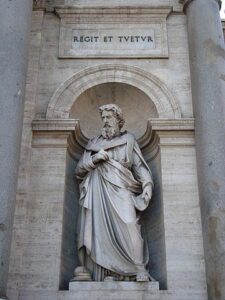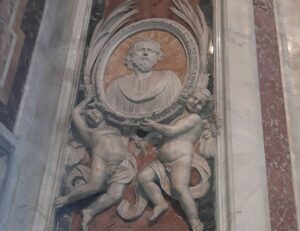Apostle Paul and First New Testament
The Apostle Paul had many students as he spread the Christian message worldwide. Many of these students are lost to history, but some names are preserved in his writings. These students and their spiritual descendants become important links in the chain of custody of New Testament writings.
In an earlier post, we discussed how the students of the Apostle John carried the Christian message from John to the first written New Testament in 350 AD. Each student carried the gospel message from their predecessor and then passed it to their students.
A similar situation occurred with the Apostle Paul’s students as they sequentially carried the gospel message initially heard from Paul to the first written New Testament.
Paul wrote the largest portion of the New Testament and was closely associated with several of the original twelve apostles. Paul also knew historians and eyewitnesses of the Resurrection and surrounding events to write his epistles encouraging others throughout the church. For example, Paul’s friend Luke was a physician and meticulous historian who carefully documented the history of the New Testament church.
Paul had several other students who protected and transmitted his writings to subsequent generations of believers. Paul’s chain of custody is more difficult to trace than John’s, but his influence is felt throughout the Gentile world of his time.
Linus and Clement of Rome – Students of the Apostle Paul
One of Paul’s major accomplishments was to preach the gospel throughout the Gentile world, including Rome. He spent the last few years of his life in Rome awaiting trial. During his imprisonment, he had access to other believers and many men who would eventually lead sizeable portions of the church.
Irenaeus mentioned one of these leaders, Linus, as one of Paul’s coworkers. Paul mentions him in 2 Timothy 4:21, along with other less well-known believers named Eubulus, Pudens, and Claudia.
Peter and Paul entrusted Linus as the bishop of Rome after establishing the Christian church in Rome. Jerome described Linus as “the first after Peter to be in charge of the Roman Church.” Eusebius described him as “the first to receive the episcopate of the church at Rome, after the martyrdom of Paul and Peter.”
Clement was also a coworker with Paul and is mentioned in Philippians 4:3. He became an important assistant to Paul and Peter in the first years of the church in Rome. Clement wrote several letters, one of which still survives (The First Epistle of Clement to the Corinthians), the earliest surviving Christian document outside the New Testament. Clement wrote about the chain of custody from the apostles to his own second-generation readers.
Clement described the person and work of Christ in a very similar manner to the gospels,
The prophets predicted the life and ministry of Jesus
Jesus provided his disciples with important instructions
He taught principles as described by Mark and Luke
Christ was humble and unassuming
He was whipped
He suffered and died for our salvation
He died as a payment for our sins
He was resurrected from the dead
is alive and reigning with God
His resurrection makes our resurrection certain
We are saved by the “grace” of God through faith in Christ
He is “Lord” and the Son of God
He possesses eternal glory and majesty
All creation belongs to Him
He is our “refuge” and our “High Priest.”
He is our “defender” and “helper.”
The church belongs to Him.
Evaristus – a Student
The name “Evaristus” may not be well known to most Christians, but he is an important link in the chain of custody from Paul to the first complete Bible.
He was Greek by birth and fathered by a Jew from Bethlehem. He became the bishop of Rome after Clement.
Eusebius stated that Evaristus died in the twelfth year of the reign of the Roman Emperor Trajan after being a bishop for about eight years. It is thought that he likely was a martyr, although this is not certain.
Alexander

By LPLT – Own work, CC BY-SA 3.0, https://commons.wikimedia.org/w/index.php?curid=6196080. The Latin phrase is “governs and protects.”
Alexander was the bishop of Rome after Evaristus. He continued the chain of support of the Biblical books that are contained within the Codex Sinaticus – the older written Bible.
Much was written about this bishop, but it may just be a legend. For example, a tradition holds that Alexander converted the Roman governor Hermes and his household by miraculous means.
Sextus
Sextus is the next in line of custody after Alexander’s death. The name of this bishop of Rome may derive from the Greek word for “shaved.”
He was a Roman by birth and ruled during the reign of Emporer Hadrian. He is thought to have been buried next to Peter on Vatican Hill, although his remains were likely distributed throughout the Christian world.
Telesphorus
Telesphorus is the next in the line of custody of the ancient Biblical books of the New Testament that would be incorporated into the first written Bible.
He was first a hermit monk (possibly living on Mount Carmel) before becoming bishop of Rom. According to Irenaeus, he suffered “glorious” martyrdom. This makes him the earliest attested martyr among the first bishops of Rome.
He is attributed with the custom of celebrating Easter on Sunday rather than on the Jewish day for the Passover, which usually occurs on a weekday.
Hyginus

By Bocachete – Own work, Public Domain, https://commons.wikimedia.org/w/index.php?curid=8885534
Hyginus assumes the role of being in the chain of custody line for the books of the New Testament. Tradition states that he was the bishop of Rome who determined the grades of the ecclesiastical hierarchy among the clergy.
He is credited with instituting godparents at baptism to assist the baptized during their Christian life.
He is thought to be Greek by birth but lived in Rome. He may have died a martyr, although this is uncertain.
Pius
Pius is next in line to have custody of the ancient New Testament books. He tried to settle the Easter controversy by insisting that it should only be kept on a Sunday.
He was also instrumental in opposing various heresies, including Gnostics and Marcion. These two heresies were becoming more popular in the Christian world.
There is some discussion he might have been a martyr, although this is uncertain.
Justin Martyr
Justin of Caesarea was an important philosopher and contributor to the history of Christianity. He is one of the earliest Christian apologists who attempted to establish orthodox theology.
Greek parents raised him as a pagan, but he eventually converted to Christianity as he studied philosophy. He taught Christian doctrine during the rule of bishop Pius in Rome. Justin was inspired by the ascetic lives of the early Christians and the willingness of many of them to become martyrs. He believed Christianity was a “true philosophy.” He traveled throughout the known world, spreading the knowledge of Christianity.
He eventually traveled to Rome, where he was denounced by an opposing philosopher named Crescens. He was brought to trial during the reign of Marcus Aurelius and beheaded along with several of his students.
His writings quote many New Testament books, establishing them as reliable. We do have any surviving writings from earlier Bishops of Rome, but he established the reliability of surviving gospels and letters of the New Testament.
Tatian
Tatian was a disciple of Justin Martyr and played a role in the spiritual chain of command of the New Testament Scriptures. He was likely born in Assyria. He traveled to Rome to study the Old Testament and met Justin.
He developed a strict form of Christianity that forbade marriage and eating meat. When Justin died, Tatian was driven from the church in Rome and traveled to Syria. It was there that he wrote his most famous contribution, the Diatessaron. This is a Biblical paraphrase that recognizes all four gospels while it combines them into one work.
The Diatessaron became the standard text of the four gospels in the Syriac-speaking churches until the 5th century. At that time, it gave way to the four standard Gospels within the Peshitta version.
Summary
The students of the Apostle Paul revered the writings within the New Testament, especially the Gospels and Revelations.
These students include the earliest bishops of Rome (Popes in Roman Catholicism) who all maintained the authenticity of the original books of New Testament Scripture. They wrote and taught from these writings, establishing them as authentic and reliable.
This same testimony as to the authority and historicity of the New Testament books continues throughout the spiritual descendants of the Apostle Paul.
In short, there is no “telephone game” with the successive transmission of the New Testament Scripture.





